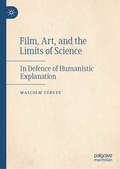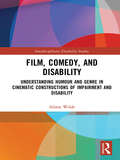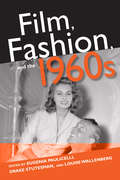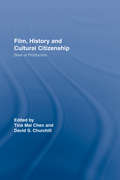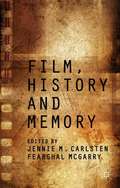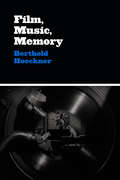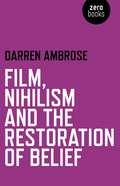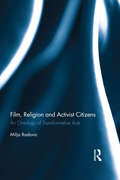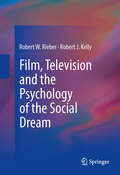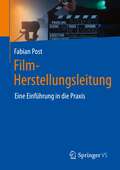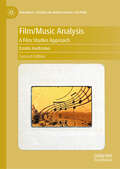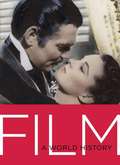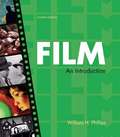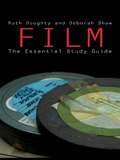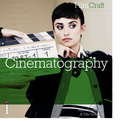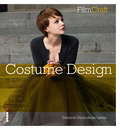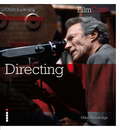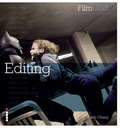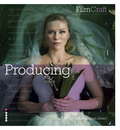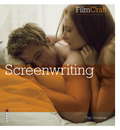- Table View
- List View
Film, Art, and the Limits of Science: In Defence of Humanistic Explanation
by Malcolm TurveyThere is currently a vigorous debate in film studies and related disciplines about the extent to which scientific paradigms like evolutionary psychology and neuroscience can explain the cinema and other artforms. This debate tends to devolve into extreme positions, with many film scholars and other humanists insisting that science has little or no role to play in the study of the arts, while a minority contends that it is always needed to fully account for cultural phenomena like film. Malcolm Turvey advocates for a more moderate position. He argues that, while the sciences can explain much about film and the other arts, there is much about these phenomena that only humanistic methods can account for. He thereby mounts a trenchant defence of the purpose and value of humanistic explanation, one that nevertheless acknowledges and welcomes the legitimate contribution of the sciences to the study of the arts.
Film, Comedy, And Disability: Understanding Humour And Genre In Cinematic Constructions Of Impairment And Disability (Interdisciplinary Disability Studies)
by Alison WildeThis book has been written in an effort to discern some of the limits to representation for portrayals of disability in media, focussing on what is attributable to cinema as a specific medium.1 I will show that there is much understanding to be gained from a synthesis of Disability Studies
Film, Fashion, and the 1960s
by Drake Stutesman Eugenia Paulicelli Louise WallenbergA fascinating look at one of the most experimental, volatile, and influential decades, Film, Fashion, and the 1960s, examines the numerous ways in which film and fashion intersected and affected identity expression during the era. From A Hard Day’s Night to Breakfast at Tiffany’s, from the works of Ingmar Bergman to Blake Edwards, the groundbreaking cinema of the 1960s often used fashion as the ultimate expression for urbanity, youth, and political (un)awareness. Crumbling hierarchies brought together previously separate cultural domains, and these blurred boundaries could be seen in unisex fashions and roles played out on the silver screen. As this volume amply demonstrates, fashion in films from Italy, France, England, Sweden, India, and the United States helped portray the rapidly changing faces of this cultural avant-gardism. This blending of fashion and film ultimately created a new aesthetic that continues to influence the fashion and media of today.
Film, History and Cultural Citizenship: Sites of Production (Routledge Studies in Cultural History)
by Tina Mai Chen; David S. ChurchillThis new book investigates the relationship of film to history, power, memory, and cultural citizenship. The book is concerned with two central issues: firstly, the participation of film and filmmakers in articulating and challenging projects of modernity; and, secondly, the role of film in shaping particular understandings of self and other to evoke collective notions of belonging. These issues call for interdisciplinary and multi-layered analyses that are ideally met through dialogue across place, time, identities and genres. The contributors to this volume enable this dialogue by considering the ways in which cultural expression and identity expressed through film serve to create notions of belonging, group identity, and entitlement within modern societies.
Film, History and Memory
by Fearghal Mcgarry Jennie M. CarlstenFilm, History and Memory examines the relationship between film and history, exploring the multiplicity of ways in which films depict, contest, reinforce or subvert historical understanding. This volume broadens the focus from 'history', the study of past events, to 'memory', the processes – individual, generational, collective or state-driven – by which meanings are attached to the past. This approach acknowledges how the significance of the historical film lies less in its empirical qualities than in its powerful capacity to influence public thinking and discourses about the past, whether by shaping collective memory, popular history and social memory, or by retrieving suppressed or marginalized histories. This study aims to contribute to the growing literature on history and film through the breadth of its approach, both in disciplinary and geographical terms. Contributors are drawn not only from the discipline of history but also film studies, film practice, art history, languages and literature, and cultural studies.
Film, Music, Memory (Cinema and Modernity)
by Berthold HoecknerFilm has shaped modern society in part by changing its cultures of memory. Film, Music, Memory reveals that this change has rested in no small measure on the mnemonic powers of music. As films were consumed by growing American and European audiences, their soundtracks became an integral part of individual and collective memory. Berthold Hoeckner analyzes three critical processes through which music influenced this new culture of memory: storage, retrieval, and affect. Films store memory through an archive of cinematic scores. In turn, a few bars from a soundtrack instantly recall the image that accompanied them, and along with it, the affective experience of the movie. Hoeckner examines films that reflect directly on memory, whether by featuring an amnesic character, a traumatic event, or a surge of nostalgia. As the history of cinema unfolded, movies even began to recall their own history through quotations, remakes, and stories about how cinema contributed to the soundtrack of people’s lives. Ultimately, Film, Music, Memory demonstrates that music has transformed not only what we remember about the cinematic experience, but also how we relate to memory itself.
Film, Nihilism and the Restoration of Belief
by Darren AmbroseDespite the cliches which govern much of its current forms, the cinema continues to have a vital political and aesthetic significance. Our commitment to, and our sincerity towards, our ways of being in the world have become catastrophically eroded. Nihilism and despair have taken hold. We must find a way to renew our faith in our capacity to transform the world, a faith that will give us back the reality of a world eroded by the restrictive capitalist ontology of modernity. How can we restore belief in the reality of a world when scepticism and universal pessimism have taken hold? Is it possible to find alternative ways of living, being and thinking? This book will discuss the means by which some filmmakers have grasped the vocation of resisting and transforming the present, of cultivating new forms of belief in the world when total alienation seems inevitable.
Film, Religion and Activist Citizens: An ontology of transformative acts
by Milja RadovicFilm can be a socio-political and artistic-transformative cultural practice through which acts and activism are performed. Going beyond ideological constructs of activism and legal definitions of citizenship, this book offers a novel approach to understanding the ontology of acts and activist citizenship, particularly in the context of their expression through film. The author approaches film as act and focuses on the scene of film as a space that goes beyond representation, constituting its own reality through which activist citizens emerge. By looking at autonomous creative acts through a range of directors' works from across the world, the author explores both the ontological and ontic dimensions of transformative acts of citizenship. In doing this the author poses the question of whether citizens are stepping out of dominant cultural ideologies to overcome social, ethnic, religious and economic divisions. This book is a fresh exploration of the ontology of acts and is essential reading for any academic interested in religion, theology, film and citizenship studies.
Film, Television and the Psychology of the Social Dream
by Robert W. Rieber Robert J. KellyThis book demonstrates how social distress or anxiety is reflected, modified, and evolves through the medium of the motion picture. Tracing cinema from its earliest forms, the authors show how film is a perfect medium for generating and projecting dreams, fantasies, and nightmares, on the individual as well as the societal level. Arising at the same time as Freud's influential ideas, cinema has been intertwined with the wishes and fears of the greater culture and has served as a means of experiencing those feelings in a communal and taming environment. From Munsterberg's original pronouncements in the early 20th century about the psychology of cinema, through the pioneering films of Melies, the works of the German expressionists, to James Bond and today's superheroes this book weaves a narrative highlighting the importance of the social dream. It develops the idea that no art form goes beyond the ordinary process of consciousness in the same way as film, reflecting, as it does, the cognitive, emotional, and volitional aspects of human nature.
Film-Herstellungsleitung: Eine Einführung in die Praxis
by Fabian PostDas Buch betrachtet alle kaufmännische relevanten Themen im Rahmen einer professionellen Spielfilm-und Serienproduktion und erläutert dieseanhand von Praxisbeispielen. Nach theoretischer Betrachtung der Themen -und einigen Anekdoten des Autors aus der Praxis- nimmt dieser den Leser an die Hand und durchläuft mit ihm gemeinsam ein fiktives Filmprojekt mit dem Titel „Mord in Studio 1“. Von der ersten Idee, über die Projektentwicklung und die Dreharbeiten hinaus, bis hin zur finalen Ablieferung des Sendebands an den TV Sender wird der Leser im Rahmen von „Mord in Studio 1“ in das Handwerk der kaufmännischen Filmproduktion durch einen erfahrenen Herstellungsleiter eingeführt.
Film/Music Analysis: A Film Studies Approach (Palgrave Studies in Audio-Visual Culture)
by Emilio AudissinoThe field of Film-Music Studies has been increasingly dominated by musicologists; this book brings the discipline back squarely into the domain of Film Studies, offering an approach in which music and visuals are seen as equal players in the game. Blending Neoformalism with Gestalt psychology and Leonard B. Meyer's musicology, this study treats music as a cinematic element, offering scholars and students of both music and film a set of tools to help them analyse the wide-ranging impact that music has in films. This second edition provides an updated survey of the field and a new chapter featuring additional case studies, including a novel analytical category for studying the contemporary 'sound-design style' film music.
Film: A World History
by Thomas Gilbert Adele Smith Daniel Borden Florian Duysens Heather ThompsonFilm: A World History takes the movie lover through all of the notable eras of filmmaking exploring the films that made them great. From Silent to Sound, the War to the Fifties, from New Wave to Hollywood blockbusters and World Cinema, the book reveals the changing face of film. Great directors and actors are also featured and this book takes the reader to all their greatest moments such as Mack Sennett and the Keystone Cops, Fred Astaire and Ginger Roberts in Top Hat, Malcolm MacDowell in A Clockwork Orange, Peter Sellers in Dr Strangelove, The Coen Brothers and Blood Simple. This guide is also packed with information that will give movie-goers an insight into film techniques, movements and genres, awards, how film has changed and all the other key information they could want. It traces the development of film and spotlights the stars of every era such as Katherine Hepburn and Orson Wells, Rock Hudson and Doris Day, Meryl Streep and Harrison Ford and cross references to their best films, the awards they have won and other interesting details. The ultimate book for any film lover.
Film: An Introduction
by William H. PhillipsFilm: An Introduction covers the movies students know and the films their instructors want them to know -- including the silent classics of D. W. Griffith and Sergei Eisenstein, the Hong Kong cinema of John Woo, the documentaries of Errol Morris and Michael Moore, and the contemporary films of Quentin Tarantino and Peter Jackson. Through meticulous coverage, an unmatched art program with over 500 frame enlargements, accessible language, and unique study tools, Film helps beginning students develop the critical skills they need to analyze films and understand the medium in all its variety.
Film: The Essential Study Guide
by Ruth Doughty Deborah ShawProviding a key resource to new students, Film: The Essential Study Guide introduces all the skills needed to succeed on a film studies course. This succinct, accessible guide covers key topics such as: Using the library Online research and resources Viewing skills How to watch and study foreign language films Essay writing Presentation skills Referencing and plagiarism Practical Filmmaking Including exercises and examples, Film: The Essential Study Guide helps film students understand how study skills are applicable to their learning and gives them the tools to flourish in their degree.
FilmCraft: Cinematography
by Mike Goodridge Tim GriersonAs chief collaborators with the directors on a film, cinematographers are artistic masters in their own right. In Cinematography sixteen of the world's greatest "painters of light" share their insights, anecdotes, and technical achievements through a series of exclusive interviews. Fascinating for both film fans and practitioners, this book is the perfect companion for anyone who wants to stand on the other side of the camera, with some of the greatest film artists of our time.
FilmCraft: Costume Design
by Deborah Nadoolman LandisActors often say they only really assume the identity of their character when they have donned the costumes painstakingly created for them by the costume designer. In this volume of the FilmCraft series of books, 16 of the world's leading costume designers come together to share their inspiration and knowledge with the reader. They provide insights into the challenges of building a team, working with budgets, and collaboration with production designers, actors and directors. Designers featured include Academy Award winners Janty Yates, Jenny Beavan, Lindy Hemming and Yvonne Blake.
FilmCraft: Directing
by Mike GoodridgeUltimately responsible for the creative content on screen, directors are the captains of the ship on every film. All actors and heads of department report to them. This title covers all the disciplines of the film art, from development and writing, to working with actors, designers and cinematographers, to postproduction and distribution.
FilmCraft: Directing
by Mike GoodridgeUltimately responsible for the creative content on screen, directors are the captains of the ship on every film. All actors and heads of department report to them. Some directors are also writers, employing unique styles of dialogue and characterizations. Others, like Pedro Almodóvar, create inimitable visual and tonal styles that set their films apart from the crowd. Unlike the other volumes in the FilmCraft series, Directing covers all the disciplines of film art that pass through the director's hands, from development and writing, to working with actors, designers and cinematographers, to post-production and distribution.
FilmCraft: Editing
by Justin ChangThe value of the editor's craft to a finished film cannot be underestimated, and it's no surprise that directors rely heavily on the same editor again and again. This book employs stills and screenshots to show how an editor created a scene with the filmmaker and explores the complex relationship between a director who has just shot a movie and the editor who must complete the director's vision. Includes perspectives from Dylan Tichenor who has worked on Boogie Nights, Brokeback Mountain, There Will Be Blood and many others and Pietro Scalia, the great editor whose partners include Bertolucci, Van San, and Ridley Scott. Each book in the FilmCraft Series focuses on a specific aspect of the filmmaking process, presenting a visually strunning look at the subject through the eyes of notable professionals in each field. Each book offers deep insight into the working practices of the world's most distinguished professionals, covering their inspiration, collaboration, and work on set. Each professional has been interviewed exclusively, and goes into detail on specific scenes in their films to give concrete examples of their craft. The result is to provide readers with a fascinating inside look at the filmmaking art, and a wealth of knowledge that they can apply to their own work.
FilmCraft: Editing
by Justin ChangThe value of the editor's craft to a finished film cannot be underestimated, and it's no surprise that directors rely heavily on the same editor over and over again. Seventeen exclusive interviews with some of the world's top film editors, including Walter Murch, Virginia Katz, Joel Cox, Tim Squyres and Richard Marks, explore the art of film editing; its complex processes, the relationship with other film practitioners, and the impact of modern editing techniques.The Filmcraft series is a ground-breaking study of the art of filmmaking-the most collaborative and multidisciplinary of all the arts. Each volume covers a different aspect of moviemaking, offering in-depth interviews with a host of the most distinguished practitioners in the field. Forthcoming titles include Cinematography, Directing, Costume Design, Production Design, Producing, Screenwriting, and Acting.
FilmCraft: Producing (Filmcraft Ser.)
by Geoffrey Macnab Sharon SwartResponsible for hiring all members of cast and crew from the director onwards, the producer s role is central to the making of any film and responsibilities can include everything from script development to securing financing to masterminding a film s marketing campaign. While few film producers are household names, they wield a degree of control that only the biggest name directors can aspire to. As with all of the "FilmCraft "titles, this book is based on new indepth interviews and features such greats as Tim Bevan, Marin Karmitz, Jeremy Thomas, Jon Kilik, Lauren Shuler Donner, Jan Chapman, and Peter Aalbaek Jensen. "
FilmCraft: Producing (Filmcraft Ser.)
by Geoffrey Macnab Sharon SwartResponsible for hiring all members of cast and crew from the director onwards, the producer's role is central to the making of any film and responsibilities can include everything from script development to securing financing to masterminding a film's marketing campaign. While few film producers are household names, they wield a degree of control that only the biggest-name directors can aspire to. As with all of the FilmCraft titles, this book is based on new indepth interviews and features such greats as Tim Bevan, Marin Karmitz, Jeremy Thomas, Jon Kilik, Lauren Shuler Donner, Jan Chapman, and Peter Aalbæk Jensen.
FilmCraft: Production Design (Filmcraft Ser.)
by Fionnuala HalliganProduction Design, the fifth title in the FilmCraft series, addresses one of the most important roles in cinema. Production designers do nothing short of creating whole new worlds, turning the bare bones of the script into a physical 3D environment that can be filmed. This book introduces that art in the words of the people best-equip to explain it, as well as looking at the legacies of the great innovators of the past. This volume also looks at the work of key influential figures, like Sir Ken Adam (winner of two Academy Awards and two BAFTAs) and Oscar winner Rick Carter (Jurassic Park, Avatar). These in-depth interviews with some of today's most distinguished practitioners, examine the training, personal qualities, pitfalls, technical expertise, management, luck and qualities which this demanding job requires.
FilmCraft: Production Design (Filmcraft Ser.)
by Fionnuala HalliganProduction designers are artistic masters in their own right. They are responsible for the 'look' of a movie; joining productions at an early stage, they coordinate costume design, special effects, set design, make-up, and location scouting to ensure a unified visual appearance. In Production Design, 16 production designers share their insights, anecdotes, and technical achievements, through a series of exclusive interviews. Fascinating for both film fans and practitioners, this book is the perfect companion for anyone who wants to learn about the craft of some of the greatest film artists of our time.
FilmCraft: Screenwriting (Filmcraft Ser.)
by Tim GriersonScreenwriting looks at the foundation on which every great film is built - the script. Whether an original concept or an adaptation, the screenplay is the key to the success of a movie - good dialogue, story pacing and character development are the framework everything else hangs on. Featuring in-depth interviews with modern masters of film including Stephen Gaghan, Guillermo Arriaga, Caroline Thompson, Hossein Amini, David Hare, David Webb Peoples and Jean-Claude Carrière, this book reveals the mysteries behind how the best scripts are written and reach the screen.
